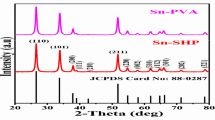Abstract
We report the preparation of a new class of organic/inorganic hybrid aerogels from aryl-bridged polysilsesquioxanes [1]. l,4-Bis(triethoxysilyl)benzene and 4,4'-bis(triethoxysilyl)-biphenyl were sol-gel processed to form phenyl- and biphenyl-bridged polysilsesquioxane gels (Figure 1, structures 1 and 2, respectively). The gels were then dried using supercritical carbon dioxide extraction. It was discovered that aryl-bridged polysilsesquioxane aerogels are indeed formed, but with a pronounced influence on surface area from the reaction conditions used in preparing the initial gels. Specifically, high surface aerogels ( up to 1750 m2/g) are obtained from gels prepared with either acid or base catalysts. With reduced concentrations of base catalyst, however, supercritical processing afforded phenyl-bridged xerogel-like materials, The materials were characterized by nitrogen sorption surface analysis, and by transmission electron microscopy.
Similar content being viewed by others
References
K. J. Shea; O. W. Webster, Chem. Materials, 1, 572, (1989)
K. J. Shea; D.A. loy; O. Webster; D. A. Loy in Better Ceramics Through Chemistry IV, edited by B.J.J. Zelinski, C. J. Brinker, D. E. Clark, D. R. Ulrich (Mater. Res. Soc. Proc., 180 Pittsburgh, PA 1990, pp 975–980.
K. J. Shea; D.A. Ioy; O.W. Webster J. Am. Chem. Soc. In Press, 4/92.
K. J. Shea; D. A. Loy; James H. Small, O. W. Webster, in preparation
D. A. Loy, Ph. D. Dissertation, University of California at Irvine, 1991.
C. J. Brinker and G.W. Scherer, Sol-Gel Science: The Physics and Chemistry of Sol-Gel Processing, Academic Press, Boston, 1990, pp. 453–515.
S. S. Kistler, Nature 122, 741 (1931).
For reviews of aerogels see: a) J. Fricke, J. Non-cryst. Solids 100, 169 (1988).
H. D. Gesser and P. C. Goswami, Chem. Reviews, 89, 765 (1989).
R. W. Pekala, J. Mater. Sci., 24(9), 3221 (1989).
Nitrogen sorption experiments were carried using a Quantachrome Autosorb Automated Gas Adsorption System; Surface areas were obtained using the five point BET method (0.02 < p/po < 0.30).
C. A. M. Mulder and J. G. Van Lierop reported a silica aerogel with a surface area of 1590 m2/g in, Aerogels (Proceedings of the First International Symposium. Wurzburg, FRG, Sept. 1985), ed. by J. Fricke, Springer-Verlag, Berlin, 1986, p. 68.
A. Kaiser, H. Schmidt, and H. Bottner, J. Membrane Sci. 22, 257 (1985).
Acknowledgements
We would like to thank Robert Dosch for the use of his gas sorption porosimeter, and Linda McLaughlin for her invaluable assistance in running the surface area analyses. We must also gratefully acknowledge the expertise of Thomas Headley, who provided us with transmission electron micrographs. This work was supported by the United States Department of Energy under contract # DE-AC04-76DP00789.
Author information
Authors and Affiliations
Rights and permissions
About this article
Cite this article
Loy, D.A., Shea, K.J. & Russick, E.M. Preparation of Aryl-Bridged Polysilsesquioxane Aerogels. MRS Online Proceedings Library 271, 699–704 (1992). https://doi.org/10.1557/PROC-271-699
Published:
Issue Date:
DOI: https://doi.org/10.1557/PROC-271-699




